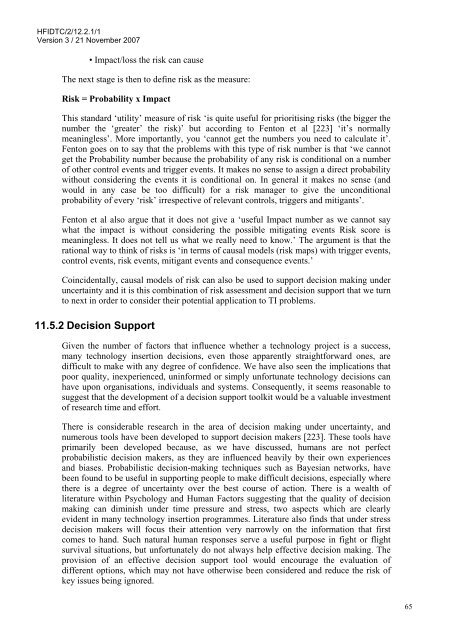The Impact of Technology Insertion on Organisations
The Impact of Technology Insertion on Organisations
The Impact of Technology Insertion on Organisations
Create successful ePaper yourself
Turn your PDF publications into a flip-book with our unique Google optimized e-Paper software.
HFIDTC/2/12.2.1/1<br />
Versi<strong>on</strong> 3 / 21 November 2007<br />
• <str<strong>on</strong>g>Impact</str<strong>on</strong>g>/loss the risk can cause<br />
<str<strong>on</strong>g>The</str<strong>on</strong>g> next stage is then to define risk as the measure:<br />
Risk = Probability x <str<strong>on</strong>g>Impact</str<strong>on</strong>g><br />
This standard ‘utility’ measure <str<strong>on</strong>g>of</str<strong>on</strong>g> risk ‘is quite useful for prioritising risks (the bigger the<br />
number the ‘greater’ the risk)’ but according to Fent<strong>on</strong> et al [223] ‘it’s normally<br />
meaningless’. More importantly, you ‘cannot get the numbers you need to calculate it’.<br />
Fent<strong>on</strong> goes <strong>on</strong> to say that the problems with this type <str<strong>on</strong>g>of</str<strong>on</strong>g> risk number is that ‘we cannot<br />
get the Probability number because the probability <str<strong>on</strong>g>of</str<strong>on</strong>g> any risk is c<strong>on</strong>diti<strong>on</strong>al <strong>on</strong> a number<br />
<str<strong>on</strong>g>of</str<strong>on</strong>g> other c<strong>on</strong>trol events and trigger events. It makes no sense to assign a direct probability<br />
without c<strong>on</strong>sidering the events it is c<strong>on</strong>diti<strong>on</strong>al <strong>on</strong>. In general it makes no sense (and<br />
would in any case be too difficult) for a risk manager to give the unc<strong>on</strong>diti<strong>on</strong>al<br />
probability <str<strong>on</strong>g>of</str<strong>on</strong>g> every ‘risk’ irrespective <str<strong>on</strong>g>of</str<strong>on</strong>g> relevant c<strong>on</strong>trols, triggers and mitigants’.<br />
Fent<strong>on</strong> et al also argue that it does not give a ‘useful <str<strong>on</strong>g>Impact</str<strong>on</strong>g> number as we cannot say<br />
what the impact is without c<strong>on</strong>sidering the possible mitigating events Risk score is<br />
meaningless. It does not tell us what we really need to know.’ <str<strong>on</strong>g>The</str<strong>on</strong>g> argument is that the<br />
rati<strong>on</strong>al way to think <str<strong>on</strong>g>of</str<strong>on</strong>g> risks is ‘in terms <str<strong>on</strong>g>of</str<strong>on</strong>g> causal models (risk maps) with trigger events,<br />
c<strong>on</strong>trol events, risk events, mitigant events and c<strong>on</strong>sequence events.’<br />
Coincidentally, causal models <str<strong>on</strong>g>of</str<strong>on</strong>g> risk can also be used to support decisi<strong>on</strong> making under<br />
uncertainty and it is this combinati<strong>on</strong> <str<strong>on</strong>g>of</str<strong>on</strong>g> risk assessment and decisi<strong>on</strong> support that we turn<br />
to next in order to c<strong>on</strong>sider their potential applicati<strong>on</strong> to TI problems.<br />
11.5.2 Decisi<strong>on</strong> Support<br />
Given the number <str<strong>on</strong>g>of</str<strong>on</strong>g> factors that influence whether a technology project is a success,<br />
many technology inserti<strong>on</strong> decisi<strong>on</strong>s, even those apparently straightforward <strong>on</strong>es, are<br />
difficult to make with any degree <str<strong>on</strong>g>of</str<strong>on</strong>g> c<strong>on</strong>fidence. We have also seen the implicati<strong>on</strong>s that<br />
poor quality, inexperienced, uninformed or simply unfortunate technology decisi<strong>on</strong>s can<br />
have up<strong>on</strong> organisati<strong>on</strong>s, individuals and systems. C<strong>on</strong>sequently, it seems reas<strong>on</strong>able to<br />
suggest that the development <str<strong>on</strong>g>of</str<strong>on</strong>g> a decisi<strong>on</strong> support toolkit would be a valuable investment<br />
<str<strong>on</strong>g>of</str<strong>on</strong>g> research time and effort.<br />
<str<strong>on</strong>g>The</str<strong>on</strong>g>re is c<strong>on</strong>siderable research in the area <str<strong>on</strong>g>of</str<strong>on</strong>g> decisi<strong>on</strong> making under uncertainty, and<br />
numerous tools have been developed to support decisi<strong>on</strong> makers [223]. <str<strong>on</strong>g>The</str<strong>on</strong>g>se tools have<br />
primarily been developed because, as we have discussed, humans are not perfect<br />
probabilistic decisi<strong>on</strong> makers, as they are influenced heavily by their own experiences<br />
and biases. Probabilistic decisi<strong>on</strong>-making techniques such as Bayesian networks, have<br />
been found to be useful in supporting people to make difficult decisi<strong>on</strong>s, especially where<br />
there is a degree <str<strong>on</strong>g>of</str<strong>on</strong>g> uncertainty over the best course <str<strong>on</strong>g>of</str<strong>on</strong>g> acti<strong>on</strong>. <str<strong>on</strong>g>The</str<strong>on</strong>g>re is a wealth <str<strong>on</strong>g>of</str<strong>on</strong>g><br />
literature within Psychology and Human Factors suggesting that the quality <str<strong>on</strong>g>of</str<strong>on</strong>g> decisi<strong>on</strong><br />
making can diminish under time pressure and stress, two aspects which are clearly<br />
evident in many technology inserti<strong>on</strong> programmes. Literature also finds that under stress<br />
decisi<strong>on</strong> makers will focus their attenti<strong>on</strong> very narrowly <strong>on</strong> the informati<strong>on</strong> that first<br />
comes to hand. Such natural human resp<strong>on</strong>ses serve a useful purpose in fight or flight<br />
survival situati<strong>on</strong>s, but unfortunately do not always help effective decisi<strong>on</strong> making. <str<strong>on</strong>g>The</str<strong>on</strong>g><br />
provisi<strong>on</strong> <str<strong>on</strong>g>of</str<strong>on</strong>g> an effective decisi<strong>on</strong> support tool would encourage the evaluati<strong>on</strong> <str<strong>on</strong>g>of</str<strong>on</strong>g><br />
different opti<strong>on</strong>s, which may not have otherwise been c<strong>on</strong>sidered and reduce the risk <str<strong>on</strong>g>of</str<strong>on</strong>g><br />
key issues being ignored.<br />
65

















